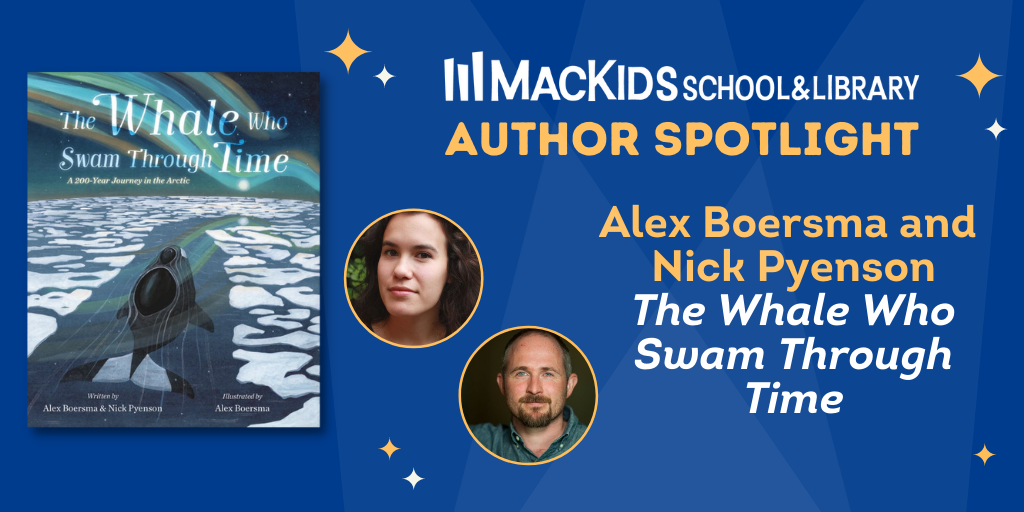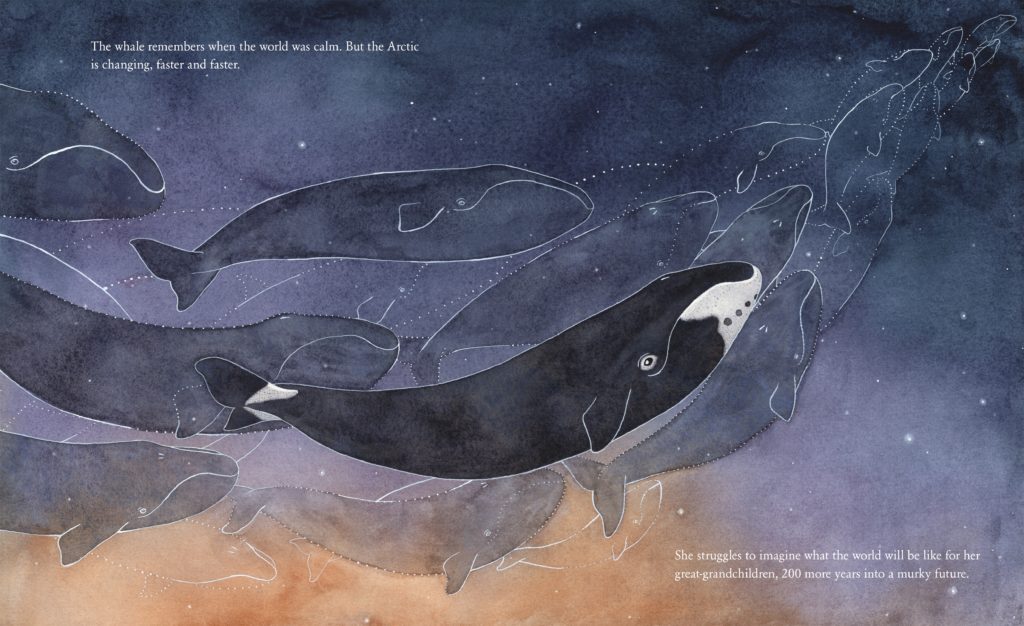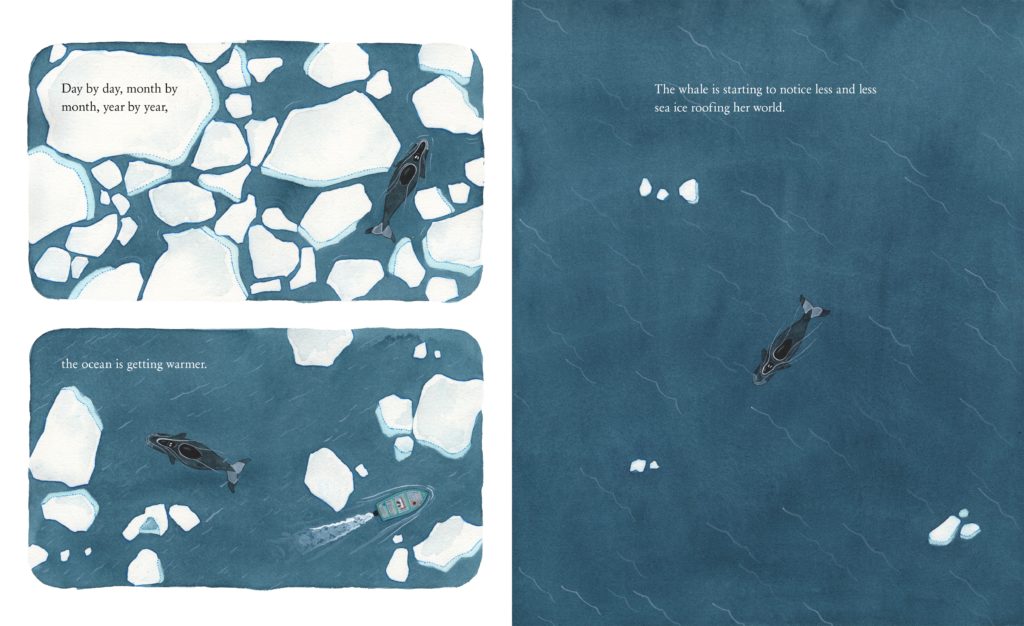
The Whale Who Swam Through Time is a sweeping nonfiction picture book explores the 200-year lifespan of a bowhead whale and the changing environment that surrounds her.
Meet the creators, Alex Boersma and Nick Pyenson and go behind the scenes of this gorgeous non-fiction book for kids.
This is one of the most creative approaches we’ve seen to examining human impact on climate change. Where did the idea start?
Alex Boersma: The idea started with Nick’s first book, an adult non-fiction book called Spying on Whales. I did the illustrations for the book, and after it was published, we immediately started talking about doing another project together. We tossed around a lot of ideas for a potential picture book, but kept coming back to the same chapter in Spying on Whales about bowhead whales, and how they can live for over 200 years. Nick described bowheads as “arctic time machines,” a living record of what the arctic was like over the last two centuries, and I just thought that was such a cool idea! What must it be like to live for 200 years, and see your world change so much?
Nick Pyenson: There are children alive right now who will remember us in 2100. And a bowhead whale born today will see much of that strange new world, and maybe well beyond to 2200. That kind of long-term thinking — based entirely on two very knowable mammals, a human and a whale — framed the narrative that we wanted to share. But we started by looking backward: the last 200 years must surely have been some of the most interesting centuries to be a bowhead whale. What did they see? And how could we tell that story? Those questions, which I hinted at in my non-fiction book Spying on Whales, led us down this path.

Do you have any recommendations for teachers or librarians who are talking to kids who are invested in protecting the environment?
Nick: Think big, use your heart, and stay positive. The future hasn’t happened yet, and I think narratives that focus on the worst potential scenarios for climate change aren’t particularly useful for kids. There’s a lot of good reasons to think that we can solve many of the world’s problems. I also think that kids alive right now get to participate in a crucial moment in human history: the time when we do figure things out. Riccardo Bozzi’s The Forest is one book that gives me hope.
Alex: It’s easy to fall into the pattern of talking about climate change in really broad terms with kids, because it’s such a big, overwhelming topic. But I think it can actually be helpful to focus on specific places, and discuss how those places will be transformed by climate change, acknowledging that the effects of climate change won’t be felt equally across the globe. That’s one of the things we wanted to highlight in our book.

What is your favorite fact about bowhead whales?
Alex: Well, obviously the fact that they can live over 200 years is pretty cool! But I think their blubber is their secret superpower they have the thickest blubber layer of any animal, almost 20 inches thick! Imagine being able to swim through arctic waters year round without getting cold, and have a built-in reservoir of food at all times. As someone who gets cold and hunger very easily, I’m very jealous of that ability.
Nick: So many facts, it’s hard to choose just one! How about that bowheads have the longest baleen plates of any filter-feeding whale, and that those plates record several years of their lives. It’s a bit like having fingernails that grow for a decade. Imagine all the information that they record!
Tell us about a librarian or educator who made an impact on you.
Nick: My aunt on my Mom’s side was a huge influence on my youth — she fueled my love of fossils, Deep Time, and big things that are hard to know. She always read so many kids books to me and my cousins and my siblings, and I can’t wait for her to read this one. I’m passing that love along, in some ways.
Alex: I majored in Earth Sciences at a small liberal arts college, and the faculty in my department were terrific. I had chosen the major because I loved nature and being outdoors, and always found myself on hikes wondering how the landscapes around me had been formed. But I had never really thought much about Deep Time before, and my professors really opened my eyes to the unimaginable time scale of our planet.
What is the first step in your creative process?
Alex: Lots of research, that comes in a lot of different forms. When I’m drawing animals (which ends up being a lot of my work), my favorite stage of research is watching as much nature documentary footage and youtube videos of that animal as I can get my hands on! I find it a lot easier (and more fun) to draw an animal after I’ve seen it move around, and observed its strange little gestures and behaviors.
Nick: Write it down. I write down the words connected to ideas that seem important — I even write out full sentences or paragraphs in long hand from other books that grab me (and always note the page number so I can go back and check for attribution). Eventually, I find that enough of those bits and sticky thoughts tend to agglomerate, and if you thread it right, you can draw a narrative. It doesn’t always work out cleanly the first time, so I feel fortunate to have had a great partner in the process with my co-author Alex.

What advice would you give to young writers?
Nick: Read good writers. Find writers you like, and read deeply into their work. What makes them interesting? What do they do well? Asking a few good questions of good writing can be a fruitful exercise.
Alex: If I’m having trouble putting words down on the page, I find it helps to try saying what I want to say out loud first, then transcribing it.
What was your favorite book when you were a teenager?
Alex: I have a terrible memory, so I don’t remember any books in particular, but in elementary school I went through a period where I was reading a LOT of YA fantasy stuff (like, a book a day). When I was a bit younger than that, I remember I really loved the Redwall books! We had the first one as a book on tape (literally, on a cassette), and I must have listened to it a hundred times.
Nick: I didn’t read enough good children’s fiction when I was little; instead, I devoured non-fiction and encyclopedia-like books. I eventually branched out into science fiction, but I feel like I missed a lot of quality fiction aimed at children. I’m happy for a second chance with my own kids. But I’ll always open any dinosaur book by Aliki.
About the AUTHOR
ABOUT THE AUTHOR:
Alex Boersma is a Canadian scientific illustrator living in Chicago. After studying geology and studio art at Vassar College in New York, Alex worked at the Smithsonian National Museum of Natural History, conducting research on whale evolution. Articles on her research have appeared in multiple news outlets, including the New York Times, BBC News, Nature, and the Washington Post. Alex has since shifted her focus to working as an independent scientific illustrator. Her clients have included the American Museum of Natural History, Woods Hole Oceanographic Institute, Stanford University, and Duke University Marine Lab, and her work ranges from scientific figures for research papers, to editorial illustrations and animation.
Nick Pyenson is the curator of fossil marine mammals at the Smithsonian Institution’s National Museum of Natural History in Washington, D.C. His work has taken him to every continent, and his scientific discoveries frequently appear in the New York Times, the Washington Post, National Geographic, Los Angeles Times, The Economist, Popular Mechanics, USA Today, on NPR, NBC, CBC, and the BBC. Along with the highest research awards from the Smithsonian, he has also received a Presidential Early Career Award for Scientists and Engineers from the Obama White House. He lives with his family in Maryland.
PRAISE FOR THE WHALE WHO SAM THROUGH TIME:
“A fine introduction for whale aficionados and a clarion call for climate change awareness.”
Kirkus Reviews


